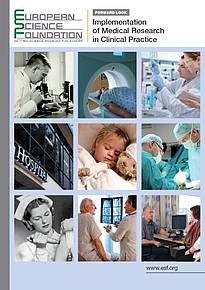List of activities
14 March 2012 Implementation Workshops, Copenhagen (DK)
11 May 2011 Press release
11 May 2011 Launch event, Berlin (DE)
14 October 2010 Consensus Conference, Strasbourg (FR)
18 May 2010 Strategic workshops, Frankfurt (DE)
18 January 2010 Scoping workshop, Copenhagen (DK)
Further information on these activities can be found here.
Background
In hospitals and primary health care, patient treatment is based on both historical development and research results. The percentage of medical treatments being evidence-based has been growing over the last 50-100 years, but still a great percentage of clinical practice is not fully evidence-based. Furthermore, new research results keep emerging, so that correct evidence-based treatment of yesterday may be outdated tomorrow. To provide patients with the best research-based treatment is an ongoing process, where updates and improvements are needed perpetually. The medical faculties also have the responsibility that following graduation, students have the competency to continuously improve quality and healthcare.
New ideas for improvement of clinical treatment are generated in everyday clinical life, and from basic science, translational science, clinical research, epidemiology, social medicine and care taken of patients in all medical specialities: neurology, neurosurgery, cardiology, haematology, surgery, dermatology, gynaecology, paediatrics etc. After a new idea is generated, a hypothesis is established and research is performed. After the research is finished, it is published in scientific journals following peer review. The timeline from publication in a journal until new treatment results are implemented in clinical practice can be varied. Sometimes it is from day to day; sometimes even good results take more than 10 years to implement.
Key stakeholders: researchers from basic research, translational research, clinical research, editors, peer reviewers, public and private funders, European Commision, industry, universities and hospitals.
After research has been published in individual research papers, it is often compiled in meta-analyses and analysed in Cochrane reviews.
Key stakeholders: researchers, statisticians, Cochrane Institutes and groups, and editors.
Research results are implemented into clinical guidelines which are documents prescribing how to treat patients in hospitals and primary care. The guidelines can be produced locally in the hospital departments, for a whole hospital, for a group of hospitals or for a country. They are often written by the researchers gathered in international scientific societies, like The European Society of Cardiology, or The European Association of Nuclear Medicine etc. Guidelines can also be initiated by public or governmental organisations and produced in collaboration with researchers. Clinical guidelines have different names in various countries; sometimes they are called reference programmes, standard operation procedures etc.
The implementation of national and international guidelines into everyday clinical practice in the hospital departments is varied across Europe and there can be several guidelines about the same subject.
Key stakeholders: clinical doctors, local committees including administrators from hospitals, clinical researchers in local guideline-writing groups, international guideline-writing groups, members of the scientific learned societies e.g., The European Society of cardiology, The European Society of Nuclear Medicine, The European Society of gastroenterology, etc. There are about 100 scientific societies covering the medical specialities in Europe.
Health Technology Assessment (HTA)
HTA is an assessment of research papers, meta-analyses, Cochrane analyses, clinical guidelines, clinical practice and patient, economy and organisation for a new treatment, new drugs, new operations, new imaging modalities etc. HTA institutes exist in many countries, they collaborate and they have mutual guidelines. In the UK for instance, there is the National Institute for Clinical Evaluation (NICE). The concept has further developed into 'miniature health technology assessment reports' made by clinical doctors to justify for hospital owners and administrators that a new treatment is documented and should be implemented. HTA reports, the NICE guidelines and early warning reports have significant elements of organisation and economy.
Key stakeholders: HTA institute staff, economists and government officials, clinical researchers and hospital owners.
Public bodies
Public bodies govern the health care area. They are called by different names in different countries, often the national board of health and the national medicine agency, and they work together in EMEA under the European Union and are based in London. The ministries of health and research are involved. Intergovernmental organisations like the World Health Organisation (WHO) are important, and in some areas a close collaboration has been established, e.g., contagious disease area / infectious diseases with the European Centre for Disease Prevention and Control (ECDC) in Stockholm.
Key stakeholders: National board of health representatives, national medicines agency and EMEA representatives, WHO, ministries, both health and research and the European Commission.
Implementation
The implementation of new research results is in the hands of the hospitals and primary health care. The hospital owners, directors and managers, together with the clinical doctors are responsible for implementing the research results into clinical practice. Sometimes it is done after HTA assessments and national and international authorities' approval/recommendation. Sometimes the implementation is on the basis of knowledge about research results published in peer review journals, sometimes it is following new guidelines, and sometimes a new treatment is implemented just as a consequence of clinical development without any resl research documentation.
Key stakeholders: a mixture of management, leadership, clinical doctors and professors.
Where are the problems?
Currently, the process from the initial idea, through research, meta-analysis and Cochrane review is working rather well. However, the process from meta-analysis through guidelines to clinical practice is a source of considerable variation throughout Europe and therefore suffers from intransparency and fragmentation. Decision-making is influenced by many non-scientific factors related to (governmental) policy, cost-effectiveness and other economic aspects (insurance, industry). This Forward Look aims to map these variations, to identify the obstacles and possible solutions for smooth and safe implementation, illuatrated by best examples.
Who are the key stakeholders?
Patients in hospitals and primary health care:
Patients are the reason for our hospitals and care facilities. Tehy should receive the best treatment, and it is unethical not to provide an updated and evidence-based treatment, if this is within reach.
Medical journals
Medical journals publish the research results. They spread the knowledge and they are crucial by publication of original papers, reviews, meta-analyses, editorials and educational articles about clinical practice.
Funders of medical research
Both public funders and private charities finance basic research, translational research and clinical research as described in the Forward Look from MED (formerly EMRC), 'Investigator-Driven Clinical Trials' and are crucial for the research. In recent years a new research area has emerged about the chain from the scientific results, through meta-analysis and Cochrane analysis, health technology assessment, NICE recommendations and into implementation. Care management research is a growing area in the United States and Europe.
Universities
The Deans and Professors at the medical faculties in Europe are responsible for basic research, translational research and clinical research in collaboration with academic medical centres and university hospitals.
Research-performing organisations
The National Institutes for Health (NIH) in the USA, Inserm in France and other similar organisations have a double role being both funders and research-performing organisations. They relate to the whole chain from basic researc, translational research, clinical research and epidemiology published as original papers, reviews etc., over meta-analysis, Cochrane reports, HTA guidelines, clinical guidelines and implementation into health care.
Scientific societies
The scientific societies are pivotal organisational structures which have important functions as they produce the guidelines. For each speciality there is scientific society. Often a great majority of the European clinical researchers in a certain field belong to the scientific society. They hold annual conferences and have a scientifid paper review journal, e.g., The European Journal of Nuclear Medicine and Molecular Imaging relatd to the European Association of Nuclear Medicine. The learned societies produce guidelines by finding the best experts in each area, who write the guidelines in pan-European collaboration often together with their American counterparts.
European pharmaceutical and medical device industry
These organisations have a certain influence on the whole chain, i.e. the everyday practice in hospitals, the creation of new research ideas and the performance of research. They influence the learned societies by being present at the annual congresses as vendors of new machines and drugs and they influence via direct sales, promotions of products. This area is by itself an important, delicate and problematic field. One could speculate that a large public relations effort is more important than the robustness of research results for determining the success of implantation of a new treatment.
Aims
The aim of this Forward Look is to give the big picture from when a new research idea is fostered, to publication and implementation into clinical practice and to provide a description of problems, best practices and recommendations for how to assure proper use of research results in the future. The goal is to assure that research results are implemented so that clinical practice is evidence-based to a larger extent than today, to create a situation for future patients with improved diagnosis, treatment, rehabilitation and care and also assure better economy and facilitated research conditons with improved funding for medical research.




